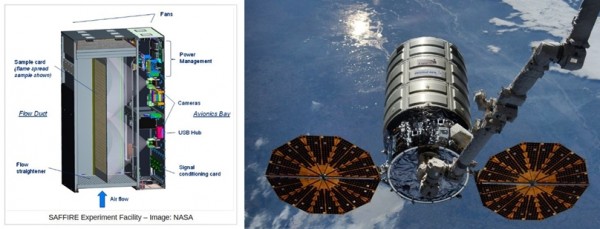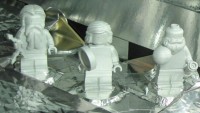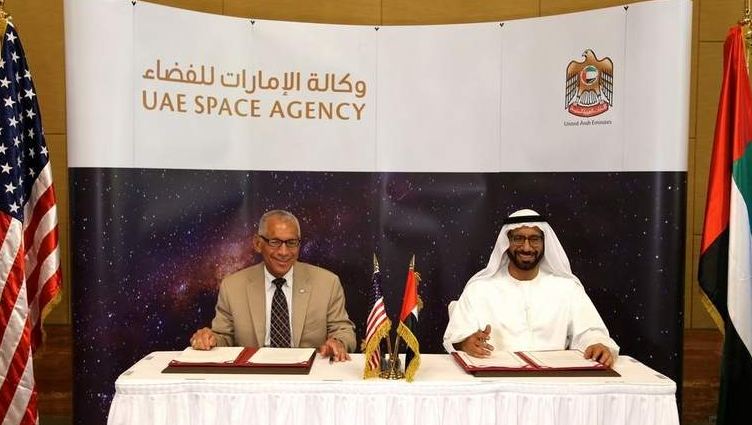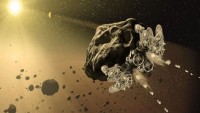NASA Intentionally Ignites Largest Man-made Fire in Space
| Arthur Dominic Villasanta | | Jun 14, 2016 10:21 PM EDT |
(Photo : NASA) SAFFIRE Experiment Facility for controlled fire and the Cygnus spacecraft OA-6
NASA has just completed a safety experiment that saw it ignite the largest controlled fire in space aboard an Orbital ATK Cygnus supply spacecraft on its return to Earth from the International Space Station (ISS).
The two-and-a-half hour-long fire in a specially built compartment aboard the unmanned Cygnus spacecraft designated OA-6 began in the early evening of June 14, New York time. NASA's Glenn Research Center was in charge of the experiment called SAFFIRE for "Spacecraft Fire Experiment."
Like Us on Facebook
It said this is the first of three SAFFIRE Experiments that together will give NASA a better understanding of how microgravity and limited oxygen affect the properties of a fire. Data from SAFFIRE will be used to improve fire safety on future crewed spacecraft and help NASA in choosing materials for future vehicles. It will study a realistic fire in microgravity on a space vehicle, looking at flame growth, temperatures and oxygen.
The SAFFIRE experiment was the largest fire in space since the accidental blaze on the Soviet Union's manned Mir space station in February 1997 that almost killed its entire crew.
NASA provided updates to the experiment in a series of tweets. One of these tweets said: "The #Saffire experiment, designed to understand fire in microgravity, is now burning successfully. #NASAexplores."
The three-part SAFFIRE Experiment I was conducted inside the SAFFIRE Experiment Unit measuring 53 x 90 x 133 centimeters affixed to internal structure of Cygnus by conventional cargo straps. Set alight inside this unit was sample material 0.4 x 1 meter in size consisting of a panel of thin material. Ignition was accomplished with a hot wire.
The next two experiments in the three-part SAFFIRE study set fire to samples the size of a hand towel. Two of the SAFFIRE Experiments examined how flame spreads in larger samples. One experiment tested different materials to assess their flammability and self extinguishing properties in the space environment.
"A spacecraft fire is one of the greatest crew safety concerns for NASA and the international space exploration community," said Gary Ruff, SAFFIRE project manager.
After the microgravity fires, Cygnus will remain in space for several days to ensure the information from the SAFFIRE Experiment is sent back to Earth. NASA said the experiment will be repeated two more times this year with other Cygnus capsules.
"SAFFIRE seeks to answer two questions," said David Urban, principal investigator. "Will an upward spreading flame continue to grow or will microgravity limit the size? Secondly, what fabrics and materials will catch fire and how will they burn?"
Tagsman-made fire inspace, NASA, Orbital ATK Cygnus, SAFFIRE, Spacecraft Fire Experiment
©2015 Chinatopix All rights reserved. Do not reproduce without permission
EDITOR'S PICKS
-

Did the Trump administration just announce plans for a trade war with ‘hostile’ China and Russia?
-

US Senate passes Taiwan travel bill slammed by China
-

As Yan Sihong’s family grieves, here are other Chinese students who went missing abroad. Some have never been found
-

Beijing blasts Western critics who ‘smear China’ with the term sharp power
-

China Envoy Seeks to Defuse Tensions With U.S. as a Trade War Brews
-

Singapore's Deputy PM Provides Bitcoin Vote of Confidence Amid China's Blanket Bans
-

China warns investors over risks in overseas virtual currency trading
-

Chinese government most trustworthy: survey
-

Kashima Antlers On Course For Back-To-Back Titles
MOST POPULAR
LATEST NEWS
Zhou Yongkang: China's Former Security Chief Sentenced to Life in Prison

China's former Chief of the Ministry of Public Security, Zhou Yongkang, has been given a life sentence after he was found guilty of abusing his office, bribery and deliberately ... Full Article
TRENDING STORY

China Pork Prices Expected to Stabilize As The Supplies Recover

Elephone P9000 Smartphone is now on Sale on Amazon India

There's a Big Chance Cliffhangers Won't Still Be Resolved When Grey's Anatomy Season 13 Returns

Supreme Court Ruled on Samsung vs Apple Dispute for Patent Infringement

Microsoft Surface Pro 5 Rumors and Release Date: What is the Latest?













